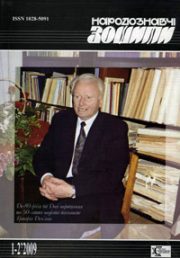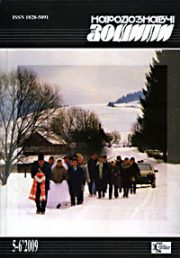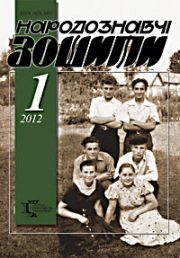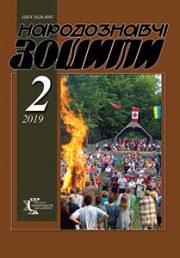The Ethnology Notebooks. 2020. # 6 (156), 1437—1444
УДК [821.161.2-94: 355.118(477)]”19″
DOI https://doi.org/10.15407/nz2020.06.1437
Iryna ROZDOLSKA
- ORCID ID https://orcid.org/0000-0002-3308-1981
- candidate of philological sciences, docent
- Ivan Franko National University of Lviv,
- docent of the Mykhailo Vozniak Department of Ukrainian Literature
- Universytetska Str., 1, 79000, Lviv, Ukraine
- e-mail: yaremchuk.iryna74@gmail.com
Article systematizes those facts of riflemen historiography concerning Ukrainian Sich Riflemen functioning as a structure, that underline and clarify it going beyond definitive boundaries of army, military unit. The revised cultural and historical conditions of the formation of the Legion prompted to summarize the generational status of the USS military formation, which, accordingly, will have significant methodological and interpretive significance for literary studies on the aesthetic phenomenon of Sichriflemen.
The object of examination are, first of all, riflemen publications, «Ukrainian Sich Riflemen» collection edited by B. Hnatkevych, monograph of S. Ripetskyy, articles of M. Kurakh, also modern intelligence of M. Lytvyn, K. Naumenko, M. Lazarovych.
The subject of examination are those features of the socio-historical structuring of the Sich Rifle Group in a broad chronological framework, from 1900 to 1920, by which its quality could be outlined. According to the author of the article, the cultural and historical conditions of the formation of the USS indicate the generational way of functioning of the military community with the spread of conciliar ideological guidelines throughout the ethnic territory of Ukraine. A clear novelty in defining the structure of the USS emphasizes the productivity of the cultural-historical approach in the analysis and search for facts, and the importance of the actual structural-generational delineation of the riflemen spiritual phenomenon not only for the historical field but also for literary studies. The article reveals the general cultural and historical attitude of the author, elements of the structural approach, as well as general scientific principles of analysis and systematization of the material.
In conclusion historiographic review actualizes research (setting)installation corresponding to generational self-awareness of Sich riflemen, according to which USS’s beginning is established far before the formal beginning of the military formation of 1914, starting the readout of the generation from the first sports companies, initiated by the participants of political independent movements, student national-educational communities, where the beginnings of riflemen ideology are hidden: ideas of state independence, militarism, national power, national unity. Shevchenko’s shift of 28.06.1914 became the public mass manifestation of the young generation within the Sich-Riflemen communities. With the beginning of the First World War paramilitary organization formed the basis of the USS Legion. Thus, the military youth emphasizes by its own example its internal unity, which goes beyond a single social structure, but considers military format the most appropriate, optimally implemented in the formation of the USS Legion, where soldiers finally and most fully outlined their military identity, passed the initiation that encourages to perceive it in terms of the properties of the generational phenomenon.
Keywords: Ukrainian Sich Riflemen, USS legion, military generation, literary studies.
REFERENCES
- Salyha, T. (Ed). (1992). Rifle Calvary: An attempt at an anthology. Lviv: Kameniar [in Ukrainian].
- Hnatkevych, B. (Ed). (1991). Ukrainian Sich Fiflemen, 1914—1920. Lviv: Slovo [in Ukrainian].
- Polonska-Vasylenko, N. (1991). History of Ukraine 1900—1923. Kyiv: Kooperatyv «Vidrodzhennia» [in Ukrainian].
- Ripetskyi, S. (1995). Ukrainian Sich Fiflemen: Liberation idea and armed action. Lviv: Scientific Society named after Shevchenko in Lviv; Ukrainian Library NTSh [in Ukrainian].
- Lazarovych, M. (2016). The Legion of Ukrainian Sich Fiflemen: formation, idea, struggle. Ternopil: Dzhura [in Ukrainian].
- Kurakh, M. (2008). Sich rifle formations in the Ukrainian armies. Visti kombatanta. Retrieved from: http://komb-a-ingwar.blogspot.com/2008/11/blog-post_11.html.
- Derevinskyy, V., Ilnytskyi, D., Liashkevych, P., & Morykvas, N. (2016). Muse and Deed of Ostap Lutskyy. Kyiv: Smoloskyp [in Ukrainian].
- Malaniuk, Ye. (2005). Return: Poetry, Literary Studies, Journalism. Diaries. Leaves. Lviv: Svit [in Ukrainian].
- Kurakh, M. (2008). Did the Sich Riflemen take part in the Winter Campaign? Visti kombatanta. 2008. Retrieved from: URL: http://komb-a-ingwar.blogspot.com/2008/10/blog-post_19.html.
- Lytvyn, M.R., & Naumenko, K.Ye. (1991). History of Galician Sich Riflemen. Lviv: Kameniar [in Ukrainian].
- Lytvyn, M.R., & Naumenko, K.Ye. (1995). History of ZUNR. Lviv: Instytut ukrainoznavstva NANU; Vydavnycha firma «OLIR» [in Ukrainian].
- Lytvyn, M., Pater, I., & Soliar, I. (Eds). (2009). Western Ukrainian People`s Republic 1918—1923. Governments, figures. Lviv: Institute of Ukrainian Studies named after Krypykevich NAS in Ukraine [in Ukrainian].







